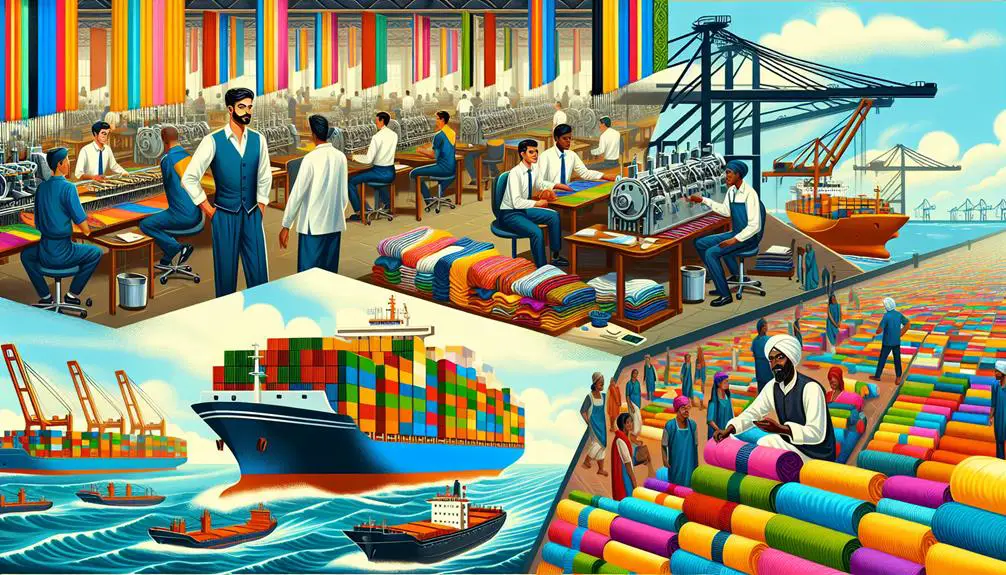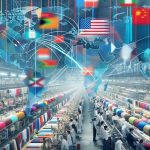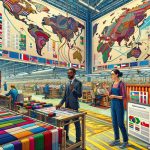You might not realize that trade policies can make or break the success of textile companies in ways that aren't immediately obvious. Tariffs on textile imports can raise production costs, altering pricing strategies and market competitiveness. Meanwhile, quotas can limit how much a company can export or import, directly impacting its growth potential. The role of subsidies and incentives in stimulating domestic innovation is another vital factor. But how do these elements interact to shape the future of the textile industry? Let's explore the intricate ways trade policies weave through every aspect of textile operations.
Table of Contents
Key Takeaways
- Tariffs on textile imports protect domestic industries but can disrupt global supply chains and impact pricing strategies.
- Quotas limit foreign goods' volume, driving up prices and potentially sparking trade disputes.
- Subsidies and incentives stimulate growth and innovation within the local textile industry by providing financial support.
- Trade agreements reduce tariffs, enhance profitability, and optimize supply chains, shaping global market dynamics.
- Export restrictions increase production costs and hinder competitiveness by limiting global market access.
Tariffs on Textile Imports
Tariffs on textile imports often play a crucial role in shaping the competitive landscape of the domestic textile industry. By imposing these tariffs, governments aim to protect local manufacturers from foreign competitors who might offer cheaper products due to lower production costs.
You need to understand that while tariffs can provide a shield for domestic industries, they can also trigger a trade war, causing significant economic impact.
When a country enforces high tariffs on textile imports, it may provoke retaliatory measures from trade partners. Such actions can escalate into a trade war, disrupting global supply chains and increasing costs for consumers and businesses alike. The economic impact isn't limited to the textile sector; it ripples through various industries that rely on textiles, such as fashion and automotive.
Moreover, tariffs can affect the pricing strategy for domestic textile companies. While they gain a temporary advantage, they may also face higher costs for imported raw materials. This delicate balance requires astute management to ensure that the economic impact remains favorable.
Impact of Quotas
Quotas on textile imports can greatly alter the market dynamics by limiting the volume of foreign goods entering a country. When you impose these import restrictions, you cap the number of textiles that can be brought in from abroad, forcing businesses to rely more heavily on domestic production. This can lead to a host of changes within the industry.
First, quota limitations can drive up the prices of imported textiles due to their reduced availability. As a result, consumers might see higher costs for clothing and other textile products. For businesses, this creates a competitive edge for local manufacturers who no longer have to contend with an endless influx of cheaper foreign goods.
Moreover, these quota limitations can spur innovation within local industries. When you restrict imports, domestic producers often need to enhance their efficiency and improve the quality of their products to meet demand. This can lead to significant advancements in technology and production techniques.
However, it's not all positive. Import restrictions might also lead to retaliation from trade partners, potentially sparking trade disputes. This could have broader economic consequences, affecting other sectors outside textiles. Therefore, while quotas can offer benefits, they also come with substantial risks.
Subsidies and Incentives
You'll find that subsidies and incentives play an essential role in the textile industry. By providing financial support, governments can stimulate growth and innovation.
These measures often help companies stay competitive in a global market.
Government Financial Support
Government subsidies and incentives can greatly bolster the textile industry, providing essential financial support for growth and innovation. When you receive government funding, it allows you to invest in new technologies, enhance production capabilities, and stay competitive in the global market. Financial assistance can come in many forms, such as tax breaks, low-interest loans, or direct grants, each designed to help you overcome financial hurdles and drive your business forward.
To make it clearer, here's a breakdown of common government financial support options:
| Financial Support Type | Description |
|---|---|
| Subsidies | Direct financial aid to reduce costs and encourage production. |
| Tax Incentives | Reductions in taxes to increase profitability and stimulate investment. |
| Low-interest Loans | Affordable loans to help finance large projects and expansions. |
Industry Growth Drivers
Harnessing subsidies and incentives can greatly expedite the growth of your textile business. By strategically utilizing government support, you can't only reduce operational costs but also fuel substantial progress. Focus on innovation strategies that differentiate your products and enhance quality. Subsidies can provide the financial backing necessary to invest in cutting-edge technologies and research and development.
Additionally, incentives can significantly streamline your supply chain optimization efforts. With proper utilization, you can improve efficiency, reduce lead times, and minimize costs, creating a more resilient supply chain. This is vital in today's competitive market, where agility and responsiveness are paramount. Government incentives often come with specific requirements, such as achieving sustainability goals or increasing local employment. Aligning your business strategies with these requirements can open up further benefits and create a positive impact on your community.
Remember that staying informed about available subsidies and incentives is crucial. Regularly check for updates on trade policies and government programs that could benefit your business.
Trade Agreements
Trade agreements play a pivotal role in shaping the textile industry's global dynamics. They impact your supply chain efficiency by reducing or eliminating tariffs, thereby lowering production costs and enhancing profitability. When countries enter into trade agreements, they create a more predictable and stable environment for businesses, allowing you to plan your logistics and operations more effectively.
Trade agreements also influence market competition. By opening up new markets and providing access to a broader customer base, these agreements can help you increase your market share. However, they can also introduce new competitors into your domestic market, challenging you to innovate and improve your product offerings.
Here's a quick look at how different trade agreements affect the textile industry:
| Trade Agreement | Impact on Textile Industry |
|---|---|
| NAFTA | Reduced tariffs, increased North American trade |
| TPP | Greater market access but heightened competition |
| EU Free Trade Agreements | Lowered costs, streamlined supply chains |
| ASEAN Free Trade Area | Enhanced regional collaboration and market access |
| USMCA | Updated regulations, maintained tariff reductions |
Understanding these dynamics allows you to leverage trade agreements to optimize your supply chain and stay ahead of market competition. By staying informed and adaptable, you can navigate the complexities of global trade with greater confidence and success.
Export Restrictions
When your country imposes export restrictions on textiles, you limit your access to the global market, which can hurt your sales and growth.
These restrictions often lead to increased production costs as you may need to source more expensive local materials.
Ultimately, you face challenges in maintaining competitiveness and profitability.
Limiting Global Market Access
Export restrictions can severely limit the global market access for textile producers. When governments impose trade barriers like tariffs and quotas, you'll find it harder to compete on the international stage. These barriers distort market competition, often making it more challenging for you to export your products at competitive prices. As a result, your ability to tap into larger, more lucrative markets diminishes, constraining your growth potential.
In addition, export restrictions disrupt the intricate balance of global supply and demand dynamics. By limiting your access to international markets, these policies can lead to an oversupply in your home country, driving down prices and profits. Conversely, restricted exports can create shortages in foreign markets, inflating prices and possibly eroding your customer base abroad. You'll find yourself caught in a cycle where your production capacity exceeds your ability to sell, creating inefficiencies and financial strain.
Moreover, navigating these trade barriers requires additional resources, from compliance costs to legal fees, diverting your focus from innovation and quality improvement. By understanding how export restrictions impact your market access, you can better strategize to mitigate these challenges and maximize your global reach.
Impact on Production Costs
You'll notice that export restrictions often lead to increased production costs due to higher prices for raw materials and disrupted supply chains. When governments impose these restrictions, it becomes harder for you to source essential materials at competitive prices. This scarcity drives up costs, which directly impacts your bottom line.
Disrupted supply chains also mean that you face delays and uncertainties. These disruptions can force you to seek alternative suppliers, often at a premium. The ripple effect extends to your production schedules, making it challenging to meet deadlines and maintain quality.
Integrating advanced technology into your operations can mitigate some of these challenges. Technology integration can streamline your supply chain management, making it more resilient to external shocks. Automation and data analytics can help you predict potential disruptions and adjust your strategies accordingly.
However, the initial investment in technology can be substantial, adding another layer of cost. Despite this, the long-term benefits often outweigh the initial expenses by enhancing efficiency and reducing dependency on volatile supply chains.
Mastering these strategies enables you to navigate the complexities of export restrictions more effectively, ensuring sustainable growth in the highly competitive textile industry.
Currency Exchange Rates
Fluctuating currency exchange rates can have a significant impact on the profitability of the textile industry. When your currency depreciates, your exports become cheaper for foreign buyers, potentially boosting sales. However, if your currency appreciates, your goods become more expensive abroad, which can hurt your competitive edge.
Exchange rate stability is essential for planning and forecasting, as it reduces market volatility and enables you to make informed decisions about pricing and contracts.
A stable exchange rate helps maintain a favorable trade balance by making it easier to predict costs and revenues. On the other hand, volatile currency movements can disrupt your supply chain and cash flow, leading to unpredictable economic impacts. For instance, sudden fluctuations can inflate the cost of imported raw materials, squeezing your profit margins.
Conversely, a favorable shift might reduce costs, but you can't always rely on such luck.
Understanding how currency exchange rates affect your business can help you implement strategies to mitigate risks. Hedging through financial instruments or diversifying your market base are practical ways to manage these fluctuations. By mastering the intricacies of currency exchange, you can better navigate the challenges and opportunities in the global textile market.
Labor and Environmental Standards
You're probably aware that labor and environmental standards play a significant role in the textile industry. Fair labor practices guarantee workers' rights and safety, while sustainable production methods help protect our planet.
Addressing these issues can lead to more ethical and eco-friendly trade policies.
Fair Labor Practices
Although trade policies aim to boost economic growth, they must also enforce fair labor practices and environmental standards to guarantee ethical production in the textile industry.
You need to make sure that ethical sourcing is a cornerstone of your business model. This means selecting suppliers who adhere to stringent labor regulations and protect their workers' rights. By focusing on ethical sourcing, you'll be promoting not just fair wages but also safe and humane working conditions, which are essential for maintaining a sustainable supply chain.
Worker conditions are another vital aspect you can't ignore. Trade policies should mandate proper working environments, including reasonable hours, adequate breaks, and a safe workplace free from harassment and exploitation. When you implement these practices, you not only comply with legal standards but also build a more loyal and motivated workforce.
Moreover, trade policies should promote transparency and accountability. You should regularly audit your supply chain to verify compliance with fair labor practices.
When your business model aligns with these ethical principles, you not only contribute to a more just society but also enhance your brand's reputation, making it more appealing to conscientious consumers.
Sustainable Production Methods
Implementing fair labor practices is just one aspect; you also need to adopt sustainable production methods that meet both labor and environmental standards. Eco-friendly practices and ethical sourcing are essential for creating a responsible textile industry. By executing these strategies, you can minimize your environmental footprint and make sure that workers are treated fairly.
First, focus on reducing waste and conserving resources. Utilize materials that are sustainable, biodegradable, or recyclable. This minimizes the environmental impact and aligns with eco-friendly practices. Next, guarantee ethical sourcing by working with suppliers who adhere to high labor standards. This not only supports fair wages and safe working conditions but also enhances your brand's reputation.
Here's a quick guide to sustainable production methods:
| Strategy | Benefits | Implementation Tips |
|---|---|---|
| Use of Organic Fibers | Reduces chemical use | Partner with certified suppliers |
| Energy-Efficient Machinery | Cuts energy consumption | Invest in modern, efficient equipment |
| Water Conservation | Decreases water usage and pollution | Implement closed-loop systems |
Intellectual Property Rights
How do intellectual property rights shape the competitive landscape of the textile industry?
They play a vital role in protecting your innovative designs and guaranteeing the uniqueness of your brand.
Without robust IP laws, your creations risk being copied, leading to IP infringement.
This not only impacts your revenue but also dilutes your brand's market presence.
To navigate this intricate landscape, you need to understand and leverage copyright protection. Here's how:
- Design Protection:
By securing copyright for your textile designs, you can prevent others from replicating your unique patterns, ensuring that your brand stands out in a crowded market.
- Trademark Safeguarding:
Trademarks protect your brand's name and logo.
This guarantees that your customers can distinguish your products from those of competitors, maintaining your brand's integrity and customer loyalty.
- Enforcing IP Laws:
Actively enforcing your IP rights is essential.
This includes monitoring the market for potential infringements and taking legal action when necessary to safeguard your interests.
Market Access Challenges
Managing market access challenges in the textile industry requires a strategic approach to overcome trade barriers and regulatory hurdles. To navigate these complexities, you need to understand the intricate market dynamics and how they impact your supply chain.
Tariffs, quotas, and stringent regulatory standards can limit your ability to enter or expand in pivotal markets. Recognizing these barriers early allows you to develop strategies to mitigate their effects.
You should also stay informed about changes in trade policies. These shifts can drastically alter market dynamics, affecting pricing and demand. By keeping abreast of policy updates, you can pivot your strategy to maintain a competitive edge.
Collaborate with local partners who understand the regulatory landscape and can provide insights that streamline your market entry.
Efficiently managing your supply chain is essential. Disruptions, whether from geopolitical tensions or logistical bottlenecks, can severely impact your ability to meet market demands. Implementing robust risk management and contingency plans ensures you remain resilient against such challenges.
Future Policy Trends
Keeping an eye on future policy trends will help you anticipate changes that could reshape the textile industry's landscape. With policy implications and global competition driving the market, staying informed is essential.
Here's what you should focus on:
- Policy Implications and Global Competition: Trade policies are constantly evolving, impacting tariffs, export restrictions, and market access. You need to monitor how these changes can affect your competitiveness on a global scale. For instance, a shift towards protectionism in major markets could limit your export potential and increase costs.
- Industry Innovation: Technology advancements are rapidly transforming the textile industry. Policies encouraging innovation can lead to significant improvements in production efficiency and product quality. Stay updated on government initiatives that support research and development, as these can provide you with opportunities for growth and competitive advantages.
- Sustainability Regulations: Environmental concerns are prompting stricter regulations on textile production. Policies aimed at reducing carbon footprints and promoting sustainable practices are becoming more prevalent. Understanding these trends will help you adapt and comply, ensuring your business remains viable in an increasingly eco-conscious market.
Frequently Asked Questions
How Do Trade Policies Influence the Cost of Raw Materials for Textile Manufacturers?
You'll notice trade policies impact raw material costs through tariff exemptions and global sourcing. Currency fluctuations and import restrictions can either raise costs or create savings, influencing your overall production expenses substantially.
What Role Do Transportation Logistics Play in the Textile Industry's Global Supply Chain?
You coordinate inventory management and global sourcing like a maestro conducts an orchestra. Efficient transportation logistics guarantee your supply chain and distribution network hum smoothly, reducing delays and costs for the textile industry's global supply chain.
How Do Changes in Consumer Demand Affect International Textile Trade?
When global demand shifts, you'll notice immediate impacts on the textile supply chain. Increased demand can strain production and logistics, while decreased demand can lead to surplus and reduced profitability, affecting international trade dynamics.
What Is the Impact of Technological Advancements on the Textile Trade Policy?
Sure, technological advancements are just minor tweaks, right? Actually, they revolutionize market trends and innovation impacts. You'll need to keep up with regulations compliance and industry standards to stay competitive in this ever-evolving textile trade landscape.
How Do Political Relationships Between Countries Influence Textile Trade Policies?
Political relationships between countries directly influence textile trade policies. When countries have strong political ties, they often create favorable trade agreements. Conversely, strained relations can lead to tariffs and trade barriers, impacting economic implications greatly.
- How Does Ring Spun Cotton Affect Garment Fit and Shape Retention? - August 13, 2024
- What Are the Challenges in Producing Ring Spun Cotton? - August 13, 2024
- Is Ring Spun Cotton Suitable for Plus-Size Clothing? - August 13, 2024







